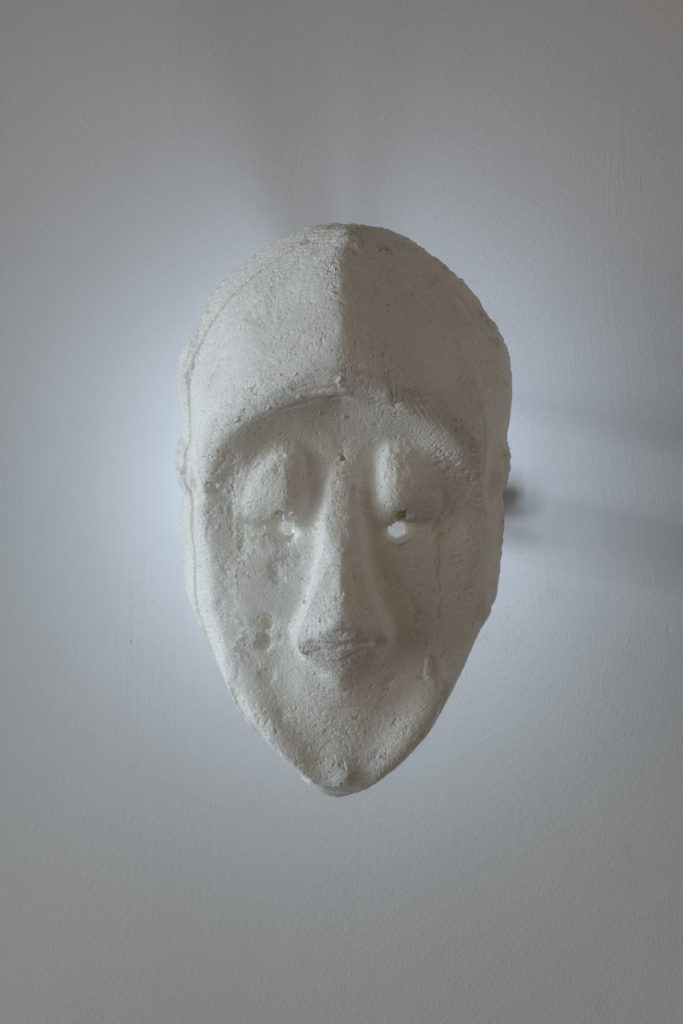Tia-Simone Gardner: Neither One or Somewhere in Between
Review by Michael Kleber-Diggs
Marsden/Gustafson Gallery
Feb 10–Apr 26, 2018

(im)migrant inhabiting the domestic
made woman – maid
a tool of the house my body
pressed to service my skin
my hide my mask an invitation
a kind of license a destination
a destiny a desired object despised
a curio to loathe and lust
kiss me if you want to kiss me
make me your vessel your vehicle
a boat a bridge a phantom
noire non nuit
(no)where (every)where
time(less) time lapse
(w)here should I rest (w)here
is my home black night
not always here never
gone I exist I am invisible
& like all good ghosts I float
By Michael Kleber-Diggs
Mask is a noun. Mask is a verb. Anywhere we hide (or are hidden) is a mask—race, identity, time, interstices, place, culture, death. Any effort we make to hide is also a mask—history, narrative, art, criticism. Depending on who wields it and why, the work of the mask is the work of concealment or erasure. Either way, behind masks, individuals disappear.
In “Neither One or Somewhere in Between,” Tia-Simone Gardner explores race, racism, racial identity and themes of time, transition, history, and gender through examination of three works, all of which feature masks (literal and figurative): Ousmane Sembéne’s classic 1966 film La Noire de… [Black Girl]; Je suis Martiniquaise [I am a Martinican Woman], a semi-autobiographical novel by Lucette Ceranus (under the pseudonym Mayotte Capécia); and Black Skin, White Masks, Franz Fanon’s examination of racism and black identity.
In the exhibition, Gardner’s literal mask is white plaster, placed and lit to cast a black shadow on the wall. The mask is mouthless, resembling the one featured in Sembéne’s film. In this video (re)telling, Ceranus discusses the Middle Passage as a present day scourge. In well-spaced frames, she moves slightly, her actions passing like time lapse, all while the background remains stolidly in place.
Gardner’s short film is a play in three acts—“DE(PART)URE ONE,” “DE(PART)URE TWO,” and “ARRIVAL / RETURN”—meant to track travels between colonial France and France, black and white, shadows and their sources, male and female, the past and the present, life and death. Gardner’s film ends with “to be continued”—part prophecy part warning—then begins again. We’re on a loop too. The past really is prologue; those who cannot remember it really are condemned to repeat it. It’s possible our racism and sexism, our xenophobia and other fears, have become less obvious or more sophisticated, but they haven’t really changed. There’s still a “middle passage,” and we’re still not doing anything to disrupt its flow.
On the opposite wall, sixty grey plates display images (some of which reappear) or text or both. Stills from the Sembéne film, text inspired by the imagination of Lucette Ceranus, now in dialogue with Fanon, all selected carefully and arranged thoughtfully. Here, as in the Sembéne film, the mask is mounted on a wall, but it also travels. It appears in front of steps, against a chain-link fence, and in the hands of a black boy. In this way, the mask becomes a vehicle, and vehicles feature prominently in Gardner’s work, especially boats. As Ceranus describes her various voyages by boat (“on a river black like ink, contrasting with the painted pale metal of a ship”), by car, and by bridge, we see images of each.
Gardner also includes a textile piece comprised of woolen white and leathery black. On viewing it, I am reminded that hide is both a noun and a verb. The same is true for skin. Rugs and blankets are masks too. To make this piece, a white sheep was shorn; a black cow died. I recall the riddle about the difference between a chicken and a pig in a bacon and eggs breakfast. We’re told the chicken was involved, but the pig was committed. Some of us are dying to tell our stories.
Everything in “Neither One or Somewhere in Between” is made in black and white or gray—tints and shades, not colors—a nod toward the interstitial like vehicles, moving water, phantom narrators with perfected memories and perspectives, stories that recur and survive, who tells them, how they are told, when and why. By drawing so heavily on past inspiration and by carrying it forward so vividly, Gardner reminds us we can’t really set urgent conversations aside. Whether the subject is a place, a thing or a person, whether the contemplated existence is corporeal or spiritual, we exist in constant dialogue with the past.
The idea to consider Sembéne’, Ceranus and Fanon is a compelling one, and Gardner has created a skillful and imaginative exhibit. I wanted more of her in the work and wondered to what extent the other works showcased here represent a mask for Gardner. While Gardner’s perspective is clear, and we can gather plenty from the intensity of her gaze at the past, from the extent of her concern in the present, and from how she assembled connected stories to make her own, when Gardner expresses herself through Sembéne’, Ceranus and Fanon, it is simultaneously easier to see the world through their experience and harder to see Gardner.
